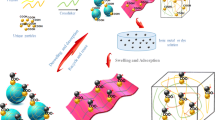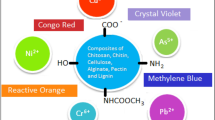Abstract
Present work focused on synthesis of green hydrogel polymer of gum rosin alcohol/psyllium crosslinked poly (acrylic acid) [(GrA-Psy)-cl-PAA] under vacuum condition. Use of both psyllium and gum rosin alcohols as backbones could lessen the burden on the environment, as more natural aspect is drawn in the hydrogel polymer. The various reaction parameters for the synthesis of hydrogel polymer were systematically optimized as a function of percentage swelling. The optimized ecofriendly hydrogel polymer was characterized using XRD, FTIR, FE-SEM and TGA techniques, which supported the successful formation of crosslinked three-dimensional network structures. (GrA-Psy)-cl-PAA was further studied as an adsorbent for the removal of methylene blue dye from an aqueous solution. Adsorption parameters such as the amount of adsorbent and pH were optimized to obtain the maximum percentage of dye removal. Kinetics of the adsorption process was analyzed using pseudo-first-order, pseudo-second-order and Elovich kinetic models. Adsorption kinetics followed pseudo-second-order model (non-linear) for all the concentrations studied. Non-linear forms of Langmuir, Freundlich and Dubinin-Kaganer-Radushkevich isotherm models were studied for the adsorption process and it was observed that it goes well with both Langmuir and Freundlich isotherms. Thermodynamic parameters were also evaluated which indicated that the adsorption process was exothermic and spontaneous. Furthermore, the candidate polymer retained a reusability tendency for two consecutive cycles of adsorption/desorption. Thus, the synthesized novel material was taken as a potential to act as green adsorbent in treatment of industrial wastewater.









Similar content being viewed by others
References
Kofinas P, Kioussis DR (2007) Reactive phosphorus removal from aquaculture and poultry productions systems using polymeric hydrogels. Environ Sci Technol 37:423–427
Kasgoz H, Ozgumus S, Orbay M (2003) Modified polyacrylamide hydrogels and their application in removal of heavy metal ions. Polymer 44:1785–1793
Bajpai SK, Johnson S (2005) Superabsorbent hydrogels for removal of divalent toxic ions. Part I: synthesis and swelling characterization. React Funct Polym 62:271–283
Kaith BS, Jindal R, Sharma R (2016) Study of ionic charge dependent salt resistant swelling behavior and removal of colloidal particles using reduced gum rosin/poly(acrylamide)-based green flocculant. Iran Polym J 25:349–362
Hosseini F, Sadighian S, Hosseini-Monfared H, Mohammad Mahmoodi N (2016) Dye removal and kinetics of adsorption by magnetic chitosan nanoparticles. Desalin Water Treat 57:1–9
Mittal H, Parashar V, Mishra SB, Mishra AK (2014) Fe3O4 MNPs and gum xanthan based hydrogels nanocomposites for the efficient capture of malachite green from aqueous solution. Chem Eng J 255:471–482
Srivastava S, Sinha R, Roy D (2004) Toxicological effects of malachite green. Aquat Toxicol 66:319–329
Kushwaha AK, Gupta N, Chattopadhyaya MC (2014) Removal of cationic methylene blue and malachite green dyes from aqueous solution by waste materials of Daucus carota. J Saudi Chem Soc 18:200–207
Muthukumar M, Selvakumar N (2004) Studies on the effect of inorganic salts on decolouration of acid dye effluents by ozonation. Dyes Pigment 62:221–228
Suna D, Zhang X, Wu Y, Liu X (2010) Adsorption of anionic dyes from aqueous solution on fly ash. J Hazard Mater 181:335–342
Shi B, Li G, Wang D, Feng C, Tang H (2004) Removal of direct dyes by coagulation: the performance of preformed polymeric aluminium species. J Hazard Mater 143:567–574
Majewska-Nowak K, Winnicki T, Wisniewski J (1989) Effect of flow conditions on ultrafiltration efficiency of dye solutions and textile effluents. Desalination 71:127–132
Kim TH, Park C, Yang J, Kim S (2004) Comparison of disperse and reactive dye removals by chemical coagulation and Fenton oxidation. J Hazard Mater 112:95–103
Dong Y, Han Z, Liu C, Du F (2010) Preparation and photocatalytic performance of Fe (III)-amidoximated PAN fiber complex for oxidative degradation of azo dye under visible light irradiation. Sci Total Environ 40:2245–2253
Amin NK (2009) Removal of direct blue-106 dye from aqueous solution using new activated carbons developed from pomegranate peel: adsorption equilibrium and kinetics. J Hazard Mater 165:52–62
Karima AB, Mounir B, Hachkar M, Bakassec M, Yaacoubi A (2009) Removal of basic red 46 dye from aqueous solution by adsorption onto Moroccan clay. J Hazard Mater 168:304–309
Tan IAW, Ahmad AL, Hameed BH (2009) Adsorption isotherms, kinetics, thermodynamics and desorption studies of 2,4,6-trichlorophenol on oil palm empty fruit bunch-based activated carbon. J Hazard Mater 164:473–482
Liu P, Zhang L (2007) Adsorption of dyes from aqueous solutions or suspensions with clay nano-adsorbents. Sep Purif Technol 58:32–39
Gupta VK, Ali I, Saini VK, Gerven TV, der Bruggen BV, Vandecasteele C (2005) Removal of dyes from wastewater using bottom ash. Ind Eng Chem Res 44:3655–3664
Li P, Su YJ, Wang Y, Liu B, Sun LM (2010) Bioadsorption of methyl violet from aqueous solution onto Pu-erh tea powder. J Hazard Mater 179:43–48
Hameed BH (2008) Equilibrium and kinetic studies of methyl violet sorption by agricultural waste. J Hazard Mater 154:204–212
Mittal H, Jindal R, Kaith BS, Maity A, Ray SS (2015) Flocculation and adsorption properties of biodegradable gum-ghatti-grafted poly(acrylamide-co-methacrylic acid) hydrogels. Carbohydr Polym 115:617–628
Mittal H, Ray SS, Kaith BS, Bhatia JK, Sukriti SJ, Alhassan SM (2018) Recent progress in the structural modification of chitosan for applications in diversified biomedical fields. Eur Polym J 109:402–434
Kaith BS, Jindal R, Mittal H, Kumar K (2010) Temperature, pH and electric stimulus responsive hydrogels from gum ghatti and polyacrylamide-synthesis, characterization and swelling studies. Der Chem Sin 1:44–54
Kaith BS, Jindal R, Mittal H, Kumar K (2012) Synthesis of crosslinked networks of gum ghatti with different vinyl monomer mixtures and effect of ionic strength of various cations on its swelling behavior. Int J Polym Mater 61:99–115
Wang L, Zhang J, Wang A (2008) Removal of methylene blue from aqueous solution using chitosan-g-poly (acrylic acid)/montmorillonite superadsorbent nanocomposite. Colloids Surf A Physiochem Eng Asp 322:47–53
Wang L, Zhang J, Wang A (2011) Fast removal of methylene blue from aqueous solution by adsorption onto chitosan-g-poly (acrylic acid)/attapulgite composite. Desalination 266:33–39
Mittal H, Maity A, Ray SS (2015) Effective removal of cationic dyes from aqueous solution using gum ghatti-based biodegradable hydrogel. Int J Biol Macromol 79:8–20
Kumar R, Sharma RK, Singh AP (2019) Synthesis and characterization of cellulose based graft copolymers with binary vinyl monomers for efficient removal of cationic dyes and Pb(II) ions. J Poly Res 26:135
Mittal H, Maity A, Ray SS (2015) Gum ghatti and poly(acrylamide-co-acrylic acid) based biodegradable hydrogel-evaluation of the flocculation and adsorption properties. Polym Degrad Stabil 120:42–52
Saruchi KV, Mittal H, Alhassan SM (2019) Biodegradable hydrogels of tragacanth gum polysaccharide to improve water retention capacity of soil and environment-friendly controlled release of agrochemicals. Int J Biol Macromol 132:1252–1261
Fischer MH, Yu N, Gray GR, Ralph J, Anderson L, Marlett JA (2004) The gel-forming polysaccharide of psyllium husk (Plantagoovata Forsk). Carbohydr Res 339:2009–2017
Izydorczyk MS, Biliaderis CG (1995) Cereal arabinoxylans: advances in structure and physicochemical properties. Carbohydr Polym 28:33–48
Singh B, Chauhan GS, Bhatt SS, Kumar K (2006) Metal ion sorption and swelling studies of psyllium and acrylic acid based hydrogels. Carbohydr Polym 64:50–56
Singh B, Bala R, Chauhan N (2008) In vitro release dynamics of model drugs from psyllium and acrylic acid based hydrogels for the use in colon specific drug delivery. J Mater Sci Mater Med 19:2771–2780
Kaith BS, Kumar K (2008) In vacuum synthesis of psyllium and acrylic acid based hydrogels for selective water absorption from different oil–water emulsions. Desalination 229:331–341
Malakootian M, Heidari MR (2018) Reactive orange 16 dye adsorption from aqueous solutions by psyllium seed powder as a low-costbiosorbent: kinetic and equilibrium studies. App Water Sci 8:212
Mirzaei S, Javanbakht V (2019) Dye removal from aqueous solution by a novel dual cross-linked biocomposite obtained from mucilage of Plantagopsyllium and eggshell membrane. Int J Biol Macromol 134:1187–1204
Maiti S, Ray SS, Kundu AK (1989) Rosin: a renewable resource for polymer and polymer chemicals. Prog Polym Sci 14:297–338
Liu X, Xin W, Zhang J (2009) Rosin-based acid anhydrides as alternatives to petrochemical curing agents. Green Chem 11:1018–1025
Abeer MM, Amin MCIM, Lazim AM, Pandey M, Martin C (2014) Synthesis of a novel acrylatedabietic acid-g-bacterial cellulose hydrogel by gamma irradiation. Carbohyd Polym 110:505–512
Tan WX, Lin ZT, Bu HT, Tian Y, Jiang GB (2012) Nano-micelles based on a rosin derivative as potent sorbents and sinking agents with high absorption capabilities for the removal of metal ions. RSC Adv 2:7279–7289
Wang L, Shi Y, Wang Y, Zhang H, Zhou H, Wei Y, Tao S, Ma T (2014) Composite catalyst of rosin carbon/Fe3O4: highly efficient counter electrode for dye-sensitized solar cells. Chem Commun 50:1701–1703
Zheng Y, Yao K, Lee J, Chandler D, Wang J, Wang C, Chu F, Tang C (2010) Well-defined renewable polymers derived from gum rosin. Macromolecules 43:5922–5924
Kaith BS, Jindal R, Sharma R (2015) Synthesis of a gum rosin alcohol-poly(acrylamide) based adsorbent and its application in removal of malachite green dye from waste water. RSC Adv 5:43092–43104
Kaur S, Jindal R (2018) Synthesis of interpenetrating network hydrogel from (gum Copal alcohols-collagen)-co-poly(acrylamide) and acrylic acid: isotherms and kinetics study for removal of methylene blue dye from aqueous solution. Mater Chem Phys 220:75–86
Wadhera P, Jindal R, Dogra R (2019) Synthesis of semi interpenetrating network hydrogel [(GrA-Psy)-cl-poly (AA)] and its application for efficient removal of Malachite green from aqueous solution. Polym Eng Sci 59:1417–1427
Singh V, Tiwari A, Sanghi R (2005) Studies on K2S2O8/ascorbic acid initiated synthesis of Ipomoea dasyspermaseed gum-g-poly(acrylonitrile): a potential industrial gum. J App Polym Sci 98:1652–1662
Singh V, Tiwari A, Pandey S, Singh SK (2007) Peroxydisulfate initiated synthesis of potato starch-graft-poly(acrylonitrile) under microwave irradiation. Express Polym Lett 1:51–58
Kaith BS, Sharma R, Sharma K, Choudhary S, Kumar V, Lochab SP (2015) Effects of O7+and Ni9+swift heavy ions irradiation on polyacrylamide grafted gum acacia thin film and sorption of methylene blue. Vacuum 111:73–82
Sharma K, Kaith BS, Kumar V, Som S, Kalia S, Swart HC (2013) Synthesis and properties of poly(acrylamide-aniline)-grafted gum ghatti based nanospikes. RSC Adv 3:25830–25839
Mittal H, Kumar V, Saruchi RSS (2016) Adsorption of methyl violet from aqueous solution using gumxanthan/Fe3O4-based nanocomposite hydrogel. Int J Biol Macromol 89:1–11
Sekhar CP, Kalidhasan S, Rajesh V, Rajesh N (2009) Bio-polymer adsorbent for the removal of malachite green from aqueous solution. Chemosphere 77:842–847
Iqbal MJ, Ashiq MN (2007) Adsorption of dyes from aqueous solutions on activated charcoal. J Hazard Mater 139:57–66
Malana MA, Ijaz S, Ashiq MN (2010) Removal of various dyes from aqueous media onto polymeric gels by adsorption process: their kinetics and thermodynamics. Desalination 263:249–257
Kaur K, Jindal R (2019) Comparative study on the behaviour of chitosan-gelatin based hydrogel and nanocomposite ion exchanger synthesized under microwave conditions towards photocatalytic removal of cationic dyes. Carbohydr Polym 207:398–410
Umoren SA, Etim UJ, Israel AU (2013) Adsorption of methylene blue from industrial effluent using poly (vinyl alcohol). J Mater Environ Sci 4:75–86
Kaur K, Jindal R, Saini D (2019) Synthesis, optimization and characterization of PVA-co-poly(methacrylic acid) green adsorbents and applications in environmental remediation. Polym Bull 6:1–22
Mahmoud GA, Mohamed SF, Hassan HM (2014) Removal of methylene blue dye using biodegradable hydrogel and reusing in a secondary adsorption process. Desalin Water Treat 54:2765–2776
Li Z, Yi Yao Y, Wei G, Jiang W, Wang Y, Zhang L (2016) Adsorption and heat-energy-aid desorption of cationic dye on a new thermo-sensitive adsorbent: methyl cellulose/calcium alginate beads. Polym Eng Sci 56:1382–1389
Acknowledgements
One of the authors is thankful to IKGPTU for providing e-library facilities. The authors are also thankful to the Central Instrumentation facility at GNDU, Amritsar and Centre for Material Sciences and Engineering, NIT, Hamirpur for different characterization of the samples.
Author information
Authors and Affiliations
Corresponding author
Ethics declarations
Conflict of interest
This research did not receive any grant from funding agencies in the public, commercial, or not-for-profit sectors. The authors declare that they have no conflict of interest.
Electronic supplementary material
Below is the link to the electronic supplementary material.
Rights and permissions
About this article
Cite this article
Wadhera, P., Jindal, R. & Dogra, R. Insight into adsorption kinetics and isotherms for adsorption of methylene blue using gum rosin alcohol/psyllium-based green adsorbent. Iran Polym J 29, 501–514 (2020). https://doi.org/10.1007/s13726-020-00814-8
Received:
Accepted:
Published:
Issue Date:
DOI: https://doi.org/10.1007/s13726-020-00814-8




